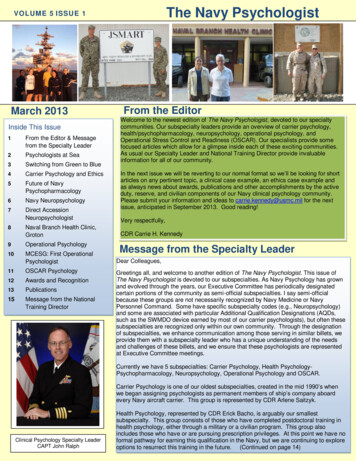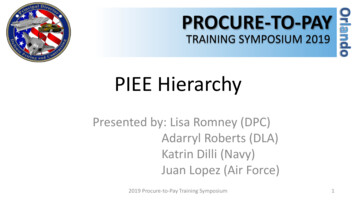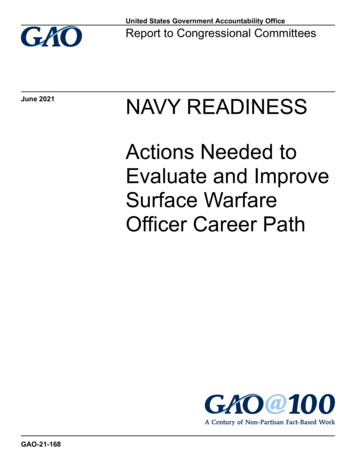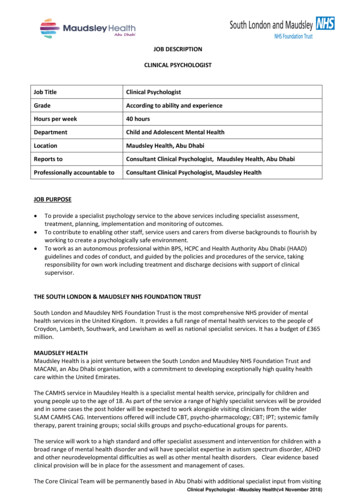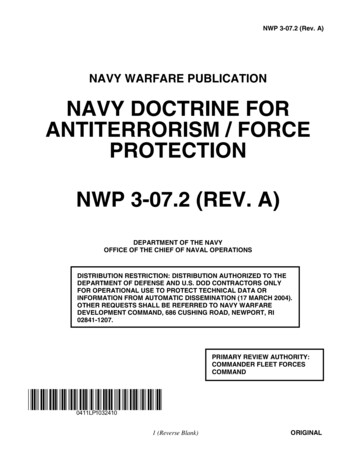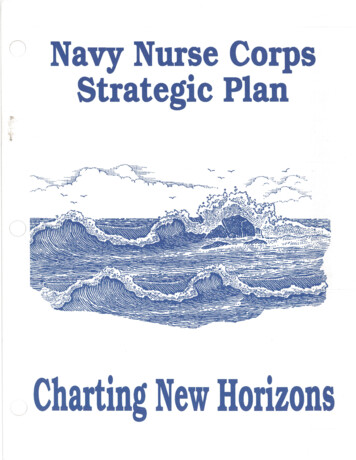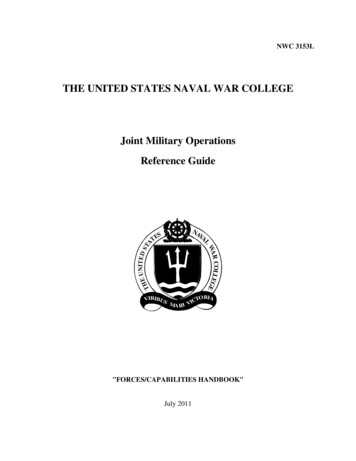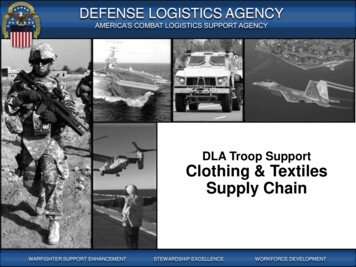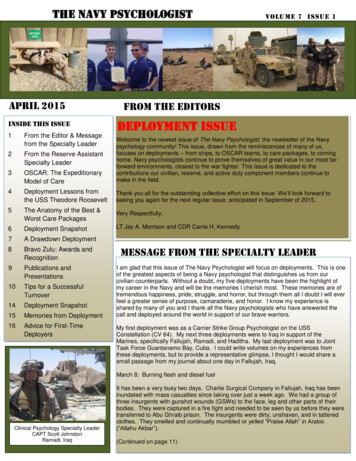
Transcription
The Navy PsychologistVOLUME 7 ISSUE 1tApril 2015Inside This IssueFrom the EditorsDEPLOYMENT ISSUE1From the Editor & Messagefrom the Specialty Leader2From the Reserve AssistantSpecialty Leader3OSCAR: The ExpeditionaryModel of CareWelcome to the newest issue of The Navy Psychologist, the newsletter of the Navypsychology community! This issue, drawn from the reminiscences of many of us,focuses on deployments – from ships, to OSCAR teams, to care packages, to cominghome. Navy psychologists continue to prove themselves of great value in our most farforward environments, closest to the war fighter. This issue is dedicated to thecontributions our civilian, reserve, and active duty component members continue tomake in the field.4Deployment Lessons fromthe USS Theodore RooseveltThank you all for the outstanding collective effort on this issue. We’ll look forward toseeing you again for the next regular issue, anticipated in September of 2015.5The Anatomy of the Best &Worst Care PackagesVery Respectfully,6Deployment SnapshotLT Jay A. Morrison and CDR Carrie H. Kennedy7A Drawdown Deployment8Bravo Zulu: Awards andRecognition9Publications andPresentations10Tips for a SuccessfulTurnover14Deployment Snapshot15Memories from Deployment16Advice for First-TimeDeployersMessage from the Specialty LeaderI am glad that this issue of The Navy Psychologist will focus on deployments. This is oneof the greatest aspects of being a Navy psychologist that distinguishes us from ourcivilian counterparts. Without a doubt, my five deployments have been the highlight ofmy career in the Navy and will be the memories I cherish most. These memories are oftremendous happiness, pride, struggle, and horror, but through them all I doubt I will everfeel a greater sense of purpose, camaraderie, and honor. I know my experience isshared by many of you and I thank all the Navy psychologists who have answered thecall and deployed around the world in support of our brave warriors.My first deployment was as a Carrier Strike Group Psychologist on the USSConstellation (CV 64). My next three deployments were to Iraq in support of theMarines, specifically Fallujah, Ramadi, and Haditha. My last deployment was to JointTask Force Guantanamo Bay, Cuba. I could write volumes on my experiences fromthese deployments, but to provide a representative glimpse, I thought I would share asmall passage from my journal about one day in Fallujah, Iraq.March 8: Burning flesh and diesel fuelClinical Psychology Specialty LeaderCAPT Scott JohnstonRamadi, IraqIt has been a very busy two days. Charlie Surgical Company in Fallujah, Iraq has beeninundated with mass casualties since taking over just a week ago. We had a group ofthree insurgents with gunshot wounds (GSWs) to the face, leg and other parts of theirbodies. They were captured in a fire fight and needed to be seen by us before they weretransferred to Abu Ghraib prison. The insurgents were dirty, unshaven, and in tatteredclothes. They smelled and continually mumbled or yelled “Praise Allah” in Arabic(“Allahu Akbar”).(Continued on page 11)
PAGE 2THE NAVY PSYCHOLOGISTMessage from the reserve assistant specialty leaderBefore 9/11, reservists mobilized infrequently. Since then, most reserve clinicalpsychologists have deployed, and some three times. Two years ago,approximately 15% of our roster was forward-deployed at any one time. Most ofthe reserve clinical psychology community had taken a turn to go forward. Theactive duty component is shouldering most of the burden now, and mobilizationsoccur less frequently. Nonetheless, we should always be ready to deploy.If you want to volunteer for a deployment, let me know. I can work to identifyrequirements.If you are involuntarily recalled to active duty, you should be given six-months notice.Use this time thoughtfully. You’ve got a lot to take care of before you leave yourfamily, home, and job.1. Contact the mobilization office at your NOSC, and obtain a copy of your orders.If they do not have them, log on to BUPERS on-line. Use the mobilization/vieworders application. You should have orders in the system. Read them carefully.They will tell your mobilization date, your intermediate stop (i.e., Navy MobilizationProcessing Site: NMPS), and your ultimate duty station, billet, and boots on theground. Your entitlements will be specified in the orders.Clinical Psychology Reserve AssistantSpecialty LeaderCDR Michael Basso2. Within three-months of your mobilization date, you should have all of the prescribed online training completed. Log intoNavy Knowledge Online. There is a prescribed curriculum for deployers. Each deployment site has its own curriculum, butthere is a common core of online courses to complete. These will take you several hours, so plan accordingly. Themobilization office of your NOSC will be able to help you identify the curriculum of courses for you to complete. Althoughthese are tedious and sometimes nonsensical (i.e., cold weather training for people deploying to Guantanamo Bay), you willreceive retirement points for them.3. Your Tricare benefits will start approximately six-months before you deploy. This is intended to facilitate you completing allmedical requirements well in advance of your report date. If you intend to have your family covered by Tricare in yourabsence, I strongly encourage you to get the paperwork submitted well in advance of your departure. I can attest that this canbe a frustrating and Kafka-esque process. Pro Tip: if you get the runaround on the phone, ask to speak with the supervisor.If you continue to get the runaround, ask to speak with the supervisor’s supervisor.4. Notify your reserve unit OIC that you are being mobilized. They should know, but they may be unaware. Pro Tip:Reschedule all of your drills for the remainder of the fiscal year before you deploy. If you don’t, you’ve left money on thetable. Moreover, you are going to be inundated with administrative, medical, and training tasks that may assume byzantinequalities. Don’t complete these tasks for free.5. Assemble a list of important contacts. Take this list during your deployment. Pro Tip: Get DSN numbers and e-mailaddresses for the NOSC mobilization office, GTCC administrator CO, XO, and operations officer. Get the phone numbersand e-mail addresses of your OIC and your reserve Command’s DFA, XO, and CO. You may need to reach back at somepoint during your deployment. Get the DSN switchboard number of your nearest military facility. When you are overseas, youcan call this switchboard, and make morale calls. Call the switchboard, and validate the morale call instructions with theoperator. Each base has slightly different rules and restrictions. Some switchboards are entirely automated, and requirespecial passcodes to work. Work out the details now. You may be given a morale call passcode at your duty station.Congratulations! You now have twice as many morale call minutes as the next guy.6. When you are within 60-days of deploying, you should have received some contact from the person you will relieve. If youhave not, contact the Expeditionary Combat Readiness Center (ECRC). The ECRC has contact with the Command you willsupport. Your NOSC mobilization office should be able to direct you to the ECRC action officer, facilitating contact with yourpredecessor. Re-read your orders. You should have called the BOQ at your NMPS site to make a reservation. You don’twant to show up at 0200 and have no place to stay. Pro-Tip: If you are going to NMPS-Norfolk, make certain that you arestaying on the base side instead of airfield side. Yes, the reservation clerk may do that to you. Ask for Maury or Decatur Hallwhen you make a reservation. Those buildings are about two blocks from the NMPS and chow hall.(Continued on page 12)
THE NAVY PSYCHOLOGISTPAGE 3OSCAR: The Expeditionary Model of CareLT Jesse LockeOperational Stress Control and Readiness or OSCAR is a uniqueexpeditionary billet that embeds mental health providers with Marine Corpsunits specifically in the Ground Combat Element (GCE). It is the OSCARprovider’s job in a deployed setting to travel the Area of Operation (AO) inorder to meet with Marines and Sailors where ever they may be. Instead ofpulling a much needed body and gun off a small base where every personcounts, the OSCAR provider goes to them in order to break down barriers tocare, reduce stigma, and keep Marines and Sailors as close to the fight aspossible.The expeditionary model of care is based on research as well as decades of warfighting experience dating back to the First World War. Doctors noticed thefurther a service member was treated from the front line the less likely they were to successfully address theirmental health symptoms. Thus, the OSCAR concept is nothing new, but it puts an unprecedented emphasis onintegrating with units and providing care as close to the front as possible.Using my own deployment as an example, the OSCAR travelled an average of three days per week to theoutlying bases to see anyone identified by medical staff, teach Corpsman about mental health issues, andspend time breaking down barriers and reducing stigma by simply being present with as many people in asmany situations as possible. Regardless of how many formal interactions occurred, Marines and Sailors werealso seen informally in the smoke pit, gym, or chow hall. In these casual settings, people seemed morecomfortable opening up about life on their current deployment or prior deployments. During a casualconversation topics ranged from an argument with a girlfriend to traumatic combat experiences. These Marinesand Sailors were not considered mental health patients as they were not seeking care and generally thestressors or discomfort were considered normal. But, by physically being there the OSCAR has the invaluableopportunity to intervene: to listen and provide education, suggestions, and normalize things early so theproblems do not become impairing. Unfortunately, the stigma associated with mental health is real, but theseexpeditionary trips were proactive in reducing the mystery (which promotes mistrust) surrounding psychologyand military psychologists.The most rewarding situations were times when Marines remembered me in different contexts or wouldrecommend a buddy. One Marine from a small and very active Patrol Base stopped me in the chow hall onCamp Leatherneck and said “Hey do you remember me; I was the guy waiting for the helicopter with you. Youknow, the one who was joking about my buddy’s wife sleeping around.” We ate lunch together and talked abouthis deployment and his apprehension with reintegration. In that short time we were able to casually processmany of his concerns about life after Afghanistan. He was heading home soon and had been engaged incombat operations steadily for five months. He was a hard charging Marine and because of our past interactionson his home turf he felt comfortable opening up. A casual lunch was quite possibly more powerful thanpsychology’s office-bound interventions.Other barriers include lack of understanding and misinformation.Commands gradually grow to understand that the OSCAR job is one offorce multiplier; someone who does their work quietly and would onlyrecommend taking someone out of the game under necessarycircumstances. The goal is to identify issues early and implementinterventions before problems grow to the point necessitating a medicalevacuation or becoming a tragedy. The persistence of OSCAR providersand support staff help to change people’s minds about psychology andpsychologists, which results in service members being more willing to getthe services that they need. ΨOSCAR psychologists enjoyluxurious accommodations.
PAGE 4THE NAVY PSYCHOLOGISTDeployment lessons from the USS Theodore RooseveltLT Justin baker and lt tahney gaigeWe as military psychologists maintain dual roles as clinicians and asofficers, artfully weaving together our command positions and collateralduties with our responsibilities to our patients. This proves to be even moredifficult in a training status when the phrase "drinking through a fire hose"and "death by PowerPoint" do not even begin to describe the breadth anddepth of knowledge needed to succeed as a Navy psychologist. Each of ushave only been Navy psychology postdoctoral fellows for four months butour experiences as riders on the USS Theodore Roosevelt (TR) for 9 days,sponsored by LCDR Duff aka "Psych Boss," afforded us the opportunity toincrease our competencies and confidence as both a psychologist and anofficer in the USN. Here are some of the most helpful takeaways from ourtime aboard ship.*"You can be doing everything right and still get killed!" This was a quote from Senior Chief Fall aboard the USS TRafter the entire psychology department was almost taken out by a jet blast up on the flight deck. It becomes everapparent the importance each worker on the flight deck plays in ensuring the safety of the pilots and deck hands inexecuting the launch and recovery of planes. Working together as a team and understanding the larger picture of themission is critical in keeping up motivation, especially during a demanding underway.*We as officers need to lead by example. The quarters start feeling quite small and lack of privacy begins to increaseirritability and induce weariness. It becomes easy for officers to lose sight of how they can keep positivity andprofessionalism alive as the excitement of the underway begins to decrease. It is in these moments that it isimperative to draw on the strength of others fostering a strong community and sense of togetherness. We sawexcellent examples of this, such as a simple, “How are you doing?” or movie nights in the ICU.*Family support is key. Both of us have never been so thankful for our social support networks than when we had toleave loved ones behind the night we boarded the ship. Being able to connect with our loved ones through Facebookmessenger and knowing that the ones left behind had support as well allowed us to focus on our tasks at hand. Thesame holds true for our patients. Helping and encouraging them to find and create supportive networks as they servein their demanding and stressful roles is essential.*Self-care. You have to see the ocean and the sky at least once a day. Practice what we preach, get a routine andtake care of yourself or you will not be able to help those 5,000 sailors' mental health you are solely responsible for.*Do things that challenge you. We both joined the Navy to serve those that serve and to seek out unique challengesafforded by the Navy. Some of those challenges include leaving the safety of our well-decorated offices and meetingthe service member where they are. This may include being catapulted off of a ship, or traveling with Marines toplaces very few people have ever heard of. In each of these situations we bring our expertise as psychologists to helpimprove the mental health of all the service members and work towards the common goal of completing the mission.Our sailors need reasons to complete 20-hour days, and psychologists underway do as well. If you do not knock ondoors or ask permission to do things outside of our normal routine we can miss out on seeing the stressors of workingand living aboard ship and experiencing all that the Navy has to offer.Which brings us to our next point of competence. Our ethics require us to act within our range of competency.Determining fitness for duty is one of those job requirements we as psychologists deal with everyday. Having a firmgrasp of the daily stressors of being on a six-on/six-off work and sleep schedule, or studying to pass the variousqualifications before the upcoming deployment is important knowledge when deciding if a particular sailor is fit to fulfilltheir duty, and will not be putting their lives or the lives of others at risk. Seeing the sailors’ workspaces was invaluabletraining that gave us hands on insight as to what it takes to competently perform the important duties aboard a carrier.We were constantly amazed at the complexity of even the simplest task completed aboard ship and how each personplayed their part in working towards the common mission of maintaining freedom of the seas. Ψ(Continued on page 6)
THE NAVY PSYCHOLOGISTPAGE 5THE ANATOMY OF THE BEST AND WORST CARE PACAKGESCDR CARRIE KENNEDY, MARINE CORPS EMBASSY SECURITY GROUPFirst, I suppose it’s always the thought that counts – better to get a carepackage when deployed than no care package! However, there is an art to themeaningful care package and maybe this short article will help family, friendsand community supports everywhere send just the right thing The fundamental truths to a care package based on a highly unscientific poll of32 deployers are in line with the general needs of human beings: take care ofbasic needs first and then work on the higher level pieces of home and nice-tohaves. And just like the old adage in elementary school, bring enough foreverybody! Always send extras in a care package – a lot of people are sentnothing in the combat zone and these boxes in tight units become almostcommunal property as well as the highlight of the day (or month ).With that said, if you are sending a care package to someone you know well, include the things they NEED. Are theyout of socks? Toothpaste? Their favorite soap? This sounds absolutely unexciting to be sure but when you can’tchange your socks regularly or your stash of soap has gone missing, life pretty much stinks (literally andfiguratively). Focus on the needs first, and if your service member is out of something important, assume that his/herfellow service members are also out and send extra.Once needs have been met, think about comfort items. Comfort items occur on a spectrum but fall into somegeneral categories: Physical Need Based, Emotional Need Based and Unique and Awesome.The following are some favorites noted by deployers:Physical Need Based: soft toilet paper, hot sauce, canned food/tuna packets (to get away from MREs), and tea andcoffee (K-cups and individually packaged instant varieties).Emotional Need Based: LETTERS from family and friends, PHOTOS from family and friends, hand crafted cardsfrom school kids, card and board games, books, a fully-loaded Kindle or Nook, current magazines,clippings/printouts from local newspapers, and DVDs (favorites are complete television series and comedies,particularly Office Space and anything with Will Ferrell in it).A note about letters and photos – yes, many deployers have some access to internet, social media, e-mail, etc.However, the tangible letter and picture that you can hold in your hand and carry around with you is still consideredthe way to go in a combat zone and that which provides the most meaning and emotional support, so always includesomething handwritten in a care package!Unique and Awesome (caution: these are individually based and may not be applicable to everyone ): Remotecontrol helicopter, lighted and decorated Christmas tree (which was placed in the Wounded Warrior Unit), vacuumcleaner, cigars, bread mix for our donated bread machine (fed the whole surgical company), Ladies Night packagewith mocktini mix, plastic martini glasses, chocolate and chick flicks on DVD, and dog treats and dog toys for theArmy therapy dog and a resident bomb sniffing dog.Which leads us to the worst things received in care packages. The number one item hands down was moldy orother inedible food. While a few people listed homemade goodies as the best thing they received, by far mostpeople felt this was the worst thing. Depending on where a person is deployed, the food is going to take at least acouple of weeks (and maybe 4 or more) to get to them and many times the weather is conducive to serious fooddecay (think 120 degree weather in the summer in Afghanistan ). Think about it before you try to send their favoritecookies, etc. – they may not make it in any edible or even recognizable format. In that same line of thinking, meltedchocolate was number 2. Ψ
PAGE 6THE NAVY PSYCHOLOGISTDEPLOYMENT SNAPSHOT:FROM EXPEDITIONARY TO ENDURING:CAMP LEMONNIER, DJIBOUTI, AFRICALT JAY A. MORRISONLocated approximately 20 miles from Yemen and 13 miles from the Somaliboarder, Camp Lemonnier is situated in the heart of one of the moststrategically vital regions to the United States and its allies. Comprised of22 tenant commands from around the globe and over 4,600 personnel, theCamp continues to grow at a rapid rate: 452 million in MilitaryConstruction Projects (MILCON) are underway, along with 48 million intenant-funded construction and 144 million in additional construction byjoint military-civilian groups. New facilities are on the horizon in every direction, as the base moves forward with avision for a lasting future: in May of 2014, the United States and the Government of Djibouti signed anImplementation Agreement that allows for base operations to continue for the next 30 years. In July of 2015, the firstbrick-and-mortar barracks is scheduled for completion to Leadership in Energy and Environmental Design (LEED)Silver standards. Life on Camp Lemonnier feels increasingly less austere by the month, with a thriving MWRprogram, a brand-new turf field, multi-denominational and multi-faith religious programs, Military Family LifeConsultants (MFLC), and Fleet & Family Services all in place. And, of course, two Green Beans locations.All of this is a far cry from the origins of the American mission here: Combined Joint Task Force – Horn ofAfrica (CJTF-HOA) was founded in October 2002 at Camp Lejeune, North Carolina, and operated off the coast ofDjibouti aboard the USS Mount Whitney until moving ashore in May of 2003. Since that time, the mission has cometo encompass a broad area of responsibility, to include Burundi, Djibouti, Eritrea, Ethiopia, Kenya, Rwanda,Seychelles, Somalia, Tanzania, and Uganda, as well as areas of interest including the Central African Republic,Chad, Comoros, the Democratic Republic of the Congo, Egypt, Mauritius, Madagascar, Mozambique, Sudan, SouthSudan, and Yemen. The increasing services available and permanency of Camp contribute considerably to theresilience of our service members whom otherwise would be living in a very challenging, and at times even harsh,environment, while conducting operations vital to our national interests and those of our allies. The Department ofExpeditionary & Operational Psychology plays an important role in supporting service members’ psychological healthdownrange, facilitating the transport of service members to a higher level of care when needed, and maintainingcommand readiness for personnel recovery and reintegration operations in the AOR. Ψ
THE NAVY PSYCHOLOGISTPAGE 7A DRAWDOWN DEPLOYMENTLT ADRIENNE MONASCOIn December 2013 I checked into Alpha Surgical Company, 1st Medical Battalion,1st Marine Logistics Group as an Individual Augmentee in support of OperationEnduringxa Freedom (OEF). Our mission was to support Combat LogisticsBattalion-7 with medical services for U.S. and – in a limited capacity – coalitionforces located at and near Camp Leatherneck, a large Marine base located inHelmand Province in southwestern Afghanistan. Services offered by Alpha Co.included mass casualty response (surgical and emergency medicine), urgentprimary care (sick call), dental, physical and occupational therapy, concussionrehabilitation, laboratory, pharmacy, and behavioral health (combat stress).We arrived mid-January 2014 with the knowledge that the OEF terminus waspending. The Afghan election season was scheduled to begin in April 2014and the outcome would greatly determine when and how we would leave thecountry. Within days of our boots hitting the ground speculation surged regarding who was going to be sent homeearly, an expression of professional anxiety about whose job was considered non-essential by the decisionmakers. During our pre-deployment workup we entertained a variety of scenarios about what we would see and doand it typically included rapid response to an incoming threat or heroically attending to the wounded. Yet thebattlespace surrounding Camp Leatherneck was not as kinetic as we expected and frankly, not as kinetic as wehoped for.Instead the work at Leatherneck Medical Complex was relatively routine and in the case of the 14.1 Alpha SurgicalCompany deployment the operational tempo of this deployment was low and slow. Our boots were on the groundto pack it up or throw it away. Both within the company and in the words of patients, people were bored.Collectively we had anticipated the dangers inherent to a combat deployment and in their absence weredisappointed, which in itself created internal conflict. Combat as a concept offered personal and professionalchallenges such as facing death and destruction with an opportunity to grow through the experience with wisdomand humility. By virtue of the profession, a psychologist fundamentally hopes for health and wellbeing of herpatients; however, a military psychologist also wants to share the combat experience. We commission as Navalofficers knowing we risk our lives but do so to more fully serve our clients. We do not wish harm upon any of ourfellow service members but there exists a guilt stained wish that something will happen so this therapist will get it;this therapist will comprehend combat in a way few other psychologists will. Without the quintessential combatexperience one may doubt her role as a military psychologist and perhaps what it truly means to be a militarypsychologist.So, we were working at an outpatient clinic that just happened to be in Afghanistan. After a few months wesuccessfully readjusted our expectations regarding our work. It was powerful to recognize that we could be just asprofessionally fulfilled with the nature of this particular deployment even though it was not what we expected. Ofcourse, the Combat Stress Clinic (CSC) did respond to traditional combat stress and psychiatric emergencies butthese were far from the dominant presenting problems. Rather, we immersed ourselves into relationship crises,career management, non-combat trauma, loss and even couples counseling; keeping Marines, sailors, soldiers,and airmen fit to fight whatever form that fight might take. Professional psychology is by nature a creativeendeavor. It is with this creativity that we encourage our patients towards change and may save ourselves in theprocess. (Continued on page 13)Psychology deployment fact:Among current Navy Psychologists, the most commondeployment was to Afghanistan, followed by an aircraft carrier,Cuba, Iraq, a MEU and D’jibouti.
PAGE 8Bravo Zulu Everyone!Navy and Marine Corps CommendationMedalLT Vahe SarkissianLT Christofer EcklundLT Kristin SomarNavy Pistol Qualification LT Ashley Clarkand LCSW LTJGLT Vahe Sarkissian (S)Patrick BakerNavy rifle qualificationLT Vahe Sarkissian (M)LTJG Aaron Weisbrod (E)LT Katherine Kline (E)LT Libby Peachey (E)LT Jessica Forde (E)THE NAVY PSYCHOLOGISTSurface Warfare Medical DepartmentOfficerLT Vahe SarkissianLCDR Nausheen MomenLCDR David J. LoomisLT Christofer Ecklunddisplay theirtan belts.Navy pistol qualificationLTJG Aaron Weisbrod (E)LTs Kline, Peachy andLT Katherine Kline (E)Forde and LTJGLT Libby Peachey (E)Weisbrod shoot Expert.LT Jessica Forde (E)Marine Corps Martial Arts (MCMAP)LT Ashley Clark – Tan BeltLCDR Loomis isawarded his SWMDO.LCDR Momen is awardedher SWMDO.DEPLOYMENT SNAPSHOTs:Guantanamo bay, cuba“Gooooooodmorning GTMO!” LTKristen Somar provides outreachto service members deployed toCuba live on the airwaves.
THE NAVY PSYCHOLOGISTBravo Zulu Everyone!PAGE 9Publications and Presentations (bolded names are Navy Psychologists)Bandermann, K.M. & Szymanski, D.M. (2014). Exploring coping mediators between heterosexist oppression and posttraumaticstress symptoms among lesbian, gay, and bisexual persons. Psychology of Sexual Orientation and Gender Diversity, 1(3), 213224.Chui, H., Hill, C.E., Ain, S., Ericson, S.K., Ganginis Del Pino, H.V., Hummel, A.M., Merson, E.S., & Spangler, P. (2014).Training undergraduate students to use challenges. The Counseling Psychologist, 42.Drum, K.B. & Littleton, H.L. (2014). Therapeutic boundaries in telepsychology: Unique issues and best practicerecommendations. Professional Psychology: Research & Practice. Advance online leton, H.L., Grills, A.E., & Drum, K.B. (2014). Predicting risky sexual behavior in emerging adulthood: Examination of amoderated mediation model among child sexual abuse and adult sexual assault victims. Violence and Victims, 29(6), 981-998.Spangler, P., Hill, C.E., Dunn, M.G., Hummel, A.M., Walden, T., Liu, J., Jackson, J., Ganginis Del Pino, H.V., & Salahuddin, N.(2014). Here-and-now: Teaching undergraduate students the skill of immediacy. The Counseling Psychologist, 42.Navy medicine blogsEmbedded Psychology with the 31st Marine Expeditionary Unit by LT Luis /archives/7993It Boils Down to Credibility by LTJG Aaron rchives/7675Putting It In Perspective by CDR Arlene chives/7529NEWEST ABPP BoardCertified Psychologists!Pre-Service Trauma: A Case Study by LT Ashley ives/7245Expressions of Gratitude Go A Long Way by LT Jay rchives/7135LT Nathan HydesCDR Joe BonvieOff to See the Wizard by CDR Carrie H. chives/7079An Intensely Personal Issue by LT Mark chives/7066Building Resilience through Adaptive Athletics by CAPT Scott L. rchives/6708Psychologists of the yearJunior: LT Jesse LockeSenior: CDR Joseph BonvieCivilian: Dr. Daniel Wright
PA
Welcome to the newest issue of The Navy Psychologist, the newsletter of the Navy psychology community! This issue, drawn from the reminiscences of many of us, focuses on deployments - from ships, to OSCAR teams, to care packages, to coming home. Navy psychologists continue to prove themselves of great value in our most far-


